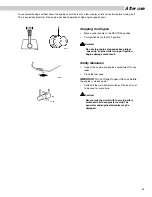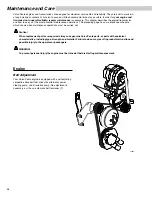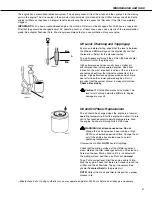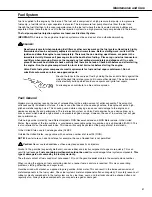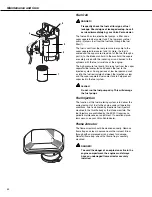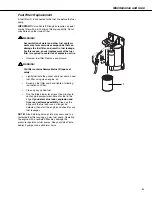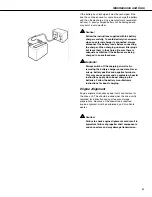
50
Maintenance and Care
Cooling System: Inhibiting
When laying up the boat for the winter it is important that
the cooling system be flushed with freshwater so that
deposits do not dry and to prevent the buildup of salt
crystals. Seawater in the system causes corrosion when
air is introduced and can cause the buildup of salt crystals
that could block the system.
Flush with clean freshwater. This work should be carried
out with the boat out of the water. Flush the cooling system
by removing the intake seawater suction hose (connected
to the seacock). Remove hose at engine. Connect another
hose of a suitable length and put its other end into a
bucket of freshwater. Keep the container filled. Remove the
thermostat and reinstall the thermostat housing.
Start the engine and let it idle for a few minutes. Stop the
engine.
Caution! The pump must never run dry.
NOTE!
Ensure that nobody is splashed with water spray-
ing out of the exhaust outlet.
To avoid corrosion in the coolant water ducts these should
be filled with either a 50/50 mixture of freshwater and
glycol, or emulsifying oil. Fill a bucket with either the 50/50
mixture or the oil. If possible fix up an overflow return to
the bucket (or another bucket). Start the engine and let it
idle. Stop the engine if the bucket starts to empty and
needs filling
Caution! The pump must never run dry.
When the engine has been running for a few minutes the
entire cooling system will have been flushed and filled with
the mixture. A 50/50 mixture of glycol and water will not
need to be drained. If emulsifying oil is used, it must be
drained if the temperature is likely to drop below freezing
while the boat is laid up.
NOTE!
Remove the impeller from the sea water pump
during winter storage.
Caution! After you have prepared the cooling
system of the engine for winter storage, using a
mixture of glycol and water, the impeller must be
rinsed and cleaned with fresh water. Glycol can
damage the rubber in the impeller.
IMPORTANT
Emulsifying oil provides no antifreeze
protection and must be drained if freezing temperatures
are likely.
To drain see
Draining cooling system.
Summary of Contents for 5.7 Gil-B
Page 2: ......
Page 15: ...13 Features 3 11 17 6 7 15 6 7 8 10 3 11 3 11 18 20 5 4 19 3590874 S 3590874 S ...
Page 17: ...15 Features 3 11 17 6 7 15 6 7 8 10 3 11 3 11 18 20 3 11 5 4 3590875 S 3590875 T 19 ...
Page 19: ...17 Features 3 11 17 6 7 15 6 7 8 10 3 11 3 11 4 18 20 3590873 S 5 19 3590873 T ...
Page 21: ...19 Features 3 11 17 6 7 15 18 6 7 8 10 3 11 3 11 19 20 3590877 S 3590877 T 5 4 ...
Page 23: ...21 Features 17 6 7 15 6 7 8 3 11 10 3590879 T 3590879 S 3 11 5 4 19 18 3 11 5 20 ...
Page 25: ...23 Features 17 6 7 15 6 7 8 3 11 10 3590880 T 3590880 S 3 11 5 4 19 18 3 11 5 20 ...
Page 27: ...25 Features 17 6 7 15 6 7 8 3 11 10 3590883 T 3590883 S 3 11 5 4 19 18 3 11 5 20 ...
Page 29: ...27 Features 17 6 7 15 6 7 8 3 11 10 3590881 T 3590881 S 3 11 5 4 19 18 3 11 5 20 ...
Page 31: ...29 Features 3 11 17 6 7 15 6 7 8 10 3 11 18 5 5 19 3 11 4 20 3590884 T 3590884 S ...
Page 69: ......
Page 70: ...7742239 English 10 2002 ...








